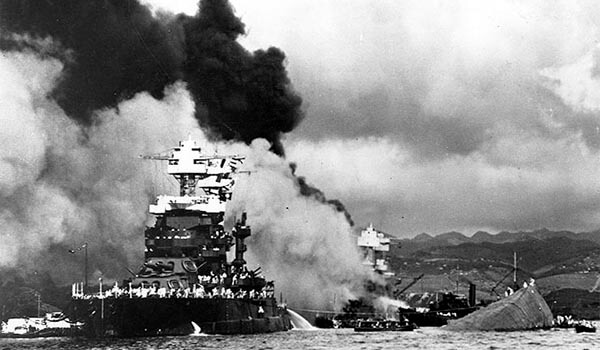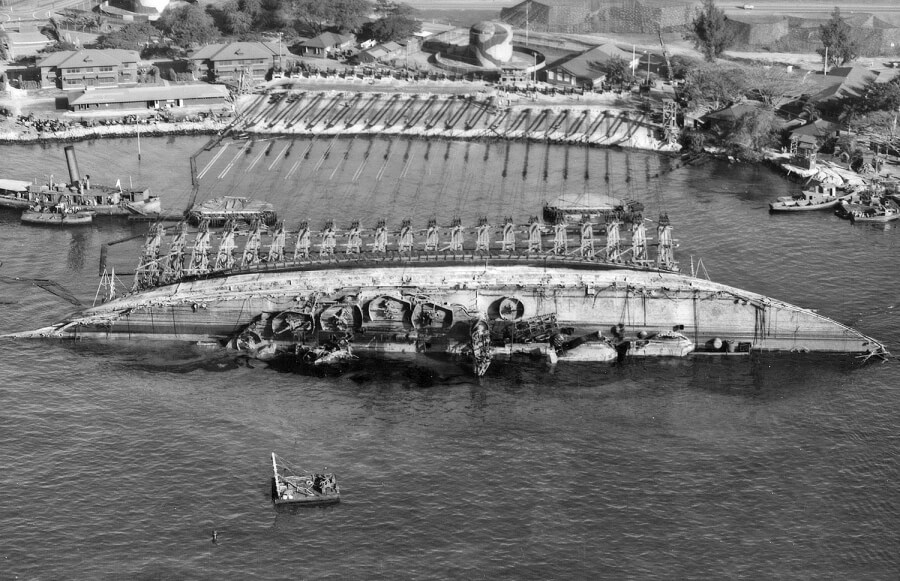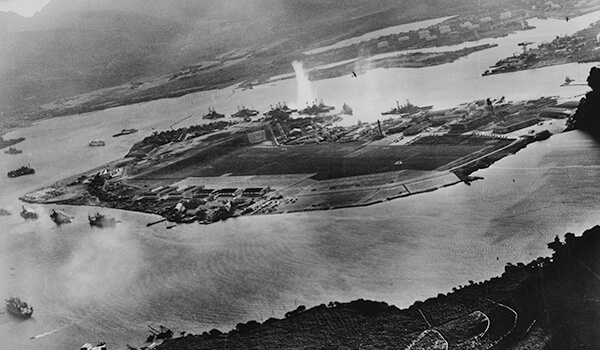By Katie Lange, Dec. 6, 2017
Defense Media Activity
Dec. 7 marks the 76th anniversary of the bombing of Pearl Harbor, a sneak attack by the Japanese in 1941 that took many American lives and thrust the United States into World War II.
The “date which will live in infamy” is commemorated yearly across the entire nation, with many survivors and their families making the pilgrimage to Oahu, Hawaii, in remembrance. While the population of military and civilian survivors from that day has dwindled, their stories and bravery have not.
Ahead of last year’s massive 75th anniversary commemoration, we interviewed several Pearl Harbor survivors about their experiences that fateful day. All these years later, they remain just as fascinating.
Pearl Harbor vet’s lucky reassignment kept him alive
This Pearl Harbor Vet’s Lucky Reassignment Kept Him Alive

Pearl Harbor veteran Floyd Welch stands near his World War II medals at his East Lyme, Connecticut, home in December 2014. Photo by John Shishmanian/NorwichBulletin.com. Used by permission.
Floyd Welch was a 19-year-old Navy electrician when the Japanese started bombing Pearl Harbor’s Battleship Row. His ship, the USS Maryland, was hit twice by torpedoes, which ripped holes in the hull below the water line.
While the damage was minimal, Welch knew he’d been lucky. Four of his colleagues died that day in compartments where the torpedoes hit, and he could have been one of them if it weren’t for a change in his duties.
Meanwhile, the Maryland was docked right beside the doomed USS Oklahoma, so Welch and his crewmates spent the rest of the day rescuing men who’d jumped off it. They also tried to cut holes through its hull to get to those who were still trapped.
A Morning of Chaos
On Dec. 7, 1941, Welch was a 19-year-old electrician on the Maryland. He had just finished showering when he heard “away fire and rescue!” over the ship’s loudspeaker.
“I ran with my clothes under my arm and just about got to the fire and rescue station when they changed it to general quarters,” Welch said, referring to his assigned battle station, which was with a repair party below deck. “You can imagine the mess it was – everybody changing in these narrow alleys, up and down the ladders and so forth.”
He heard the attack before he ever laid eyes on its destruction.
“Three decks down was where I was at that time, and from the torpedoes and bombs being dropped, I could hear it quite plainly. But none of us believed that we were at war,” Welch said.
That changed when the Maryland was hit in its forecastle by two torpedoes, which tore holes in the side of the ship below the water line.
Lucky Break or Divine Intervention?
The Maryland was the least damaged of all the battleships, but it still lost four men that day.
“I could have been one of those,” Welch said.

USS Maryland (BB-46) alongside the capsized USS Oklahoma (BB-37). USS West Virginia (BB-48) is burning in the background. Photo courtesy of U.S. Navy, National Archives collection.
Welch was moved into the repair party a few weeks before the attack. His original general quarters had been the secondary battery air-compressor room, which just happened to be one of the areas damaged by the torpedoes that struck the Maryland.
Repair crews weren’t able to pump all the water out of the damaged compartment right after the attack, so it was sealed off until Dec. 30, when the Maryland arrived at the shipyard in Bremerton, Wash. Once crews finally pumped all the water out, they found the body of Welch’s replacement in the compressor room. He had either drowned or been killed by the explosions.
“That could have been me in that torpedo air compressor instead of that fella,” Welch said.
Helping the Oklahoma
The Maryland had been tied up against concrete quays at Ford Island, with the USS Oklahoma on the neighboring outboard-site – the preferable place to dock, thanks to its cool breezes. But in this case, the Maryland was lucky to be on the inside; the Oklahoma was torpedoed five times and rolled onto its side in a matter of minutes. By the time Welch got to the top of the ship, it had already capsized.

An aerial view of salvage operations on the USS Oklahoma at Pearl Harbor. U.S. Navy photo
“She rolled over toward us and pinned us up tight against those concrete quays,” Welch remembered.” “We had to use dynamite to blow them up and let us go out.”
Welch and his fellow shipmates became crucial to the rescue of the Oklahoma’s surviving sailors.
Several of Welch’s shipmates searched for survivors in tugboats, while others lowered rope ladders to them from the Maryland’s deck.
“We were short men to man the 5-inch 38s and the machine guns and so forth. Those that we’d bring aboard – there were quite a few of them who weren’t hurt very bad — we’d put to work,” Welch said. “But those who were pretty well banged up, we would put them down where doctors could work on them.”
Others on the Maryland had water pumps going at full pressure to keep the fiery oil from reaching them, all while hiding under turrets to find cover when the Japanese planes returned.
The Maryland’s remaining sailors began the long and difficult process of cutting holes through the bottom steel plates of the Oklahoma, where they heard trapped crew members tapping on the hull. Nearly 430 sailors and Marines on the Oklahoma died that day — a loss of life that was second only to the 1,100 lost on the USS Arizona, which remains underwater to this day.

Photograph taken from a Japanese plane during the Pearl Harbor torpedo attack on ships moored on both sides of Ford Island. Battleship Row’s ships were on the far side of the photo, including the Nevada, Arizona, Tennessee, Oklahoma, Maryland, and California. Japanese planes are visible over Ford Island and over the Navy Yard. Photo courtesy of the U.S. Naval History and Heritage Command
After
The Maryland remained Welch’s home for the next four years, until he was discharged from the Navy in 1946. He returned to his Connecticut hometown, where he met and married his wife. They have six kids and several grandchildren, including two girls who are currently in the Navy.
While his memory was a bit spotty the day we talked, his love for his service was not.
“I look back, and I think the best days were the Navy days. I was so happy with the work I was doing, and I didn’t have to pull the trigger to kill somebody,” Welch said. “I was doing a job to keep that ship running. … I had to keep my electrical circuits top shape, and I enjoyed doing it.”
Visit www.dodlive.mil/2017/12/06/as-pearl-harbor-survivors-dwindle-their-stories-remain-timeless to see the rest of the story.